
I purchased my first Sibley—The Sibley Field Guide to Birds of Eastern North America—in 2003. It was my second field guide, and I quickly gave it that worn look I imagined all “real” birder’s field guides had by dropping it into the creek at Allaire State Park in New Jersey (by accident!). My Eastern Sibley served me well, replacing the Peterson’s with which I learned my ducks and waders. And, although these days I like to switch it around, sometimes using National Geographic or Stokes or a specialty guide or my Sibley phone app, that creased, dog-eared, red library tape bound book is still the field guide I keep in my car or slip into my suitcase for a trip to anywhere east of the Rockies.
So, I had mixed feelings about the publication of The Field Guide to Birds of Eastern North America: Second Edition and The Field Guide to Birds of Western North America: Second Edition, written and illustrated by David Allen Sibley, almost exactly two years after the well-publicized publication of The Sibley Guide to Birds, Second Edition. Am I willing to give up the field guide which bears the mud and dirt of so many falls on so many birding trips? The guide that flips open automatically to Semipalmated, Western, and Least Sandpipers, a testament to my continuing learning curve with peeps? A guide that feels so right in my hands? It’s a question many of us are grappling with. (Although, looking at the photo above, I don’t think it’s a question that is hard to answer.)
Here’s a look at Sibley Birds East and Sibley Birds West (the books’ cover titles), feature by feature:
Size & Cover: The new field guides are the roughly the same size as the 2003 editions, a bit higher, wider, and heavier. They offer more birds, updated text and taxonomic organization, and shiny, pretty covers featuring signature bird close-ups and abbreviated titles in large block letters. SIBLEY BIRDS EAST is the singing Rose-breasted Grosbeak and SIBLEY BIRDS WEST is the singing Lazuli Bunting. The deep colors the title lettering, red for East, Blue for West, echo the colors of the first edition (and, seem a bit ironic coming out in a presidential election year, but I’m sure that’s pure coincidence). I was a little sad to see that the newer editions don’t have the second signature birds (Wood Duck for Eastern, Tufted Puffin for Western) and regional maps on the spine. I ‘m not sure if this is part of the new design protocol or a consequence of the fact that these books are more apt to be bought online than in bookstores.
Coverage: The Rocky Mountains are the dividing line–Sibley Birds East covers birds east; Sibley Birds West covers birds west. Sibley Birds East covers “nearly 700” birds, up from 650, and Sibley Birds West covers “over 700,” which I’m assuming is more than the first edition count of 703 birds, if for no other reason than that taxonomic splits have give us Ridgeway’s Rail, Bell’s Sparrow and Sagebrush Sparrow. In addition to splits, selected rare visitors have been added (Lesser Sand-Plover, Zenaida Dove, Red-vented Bulbul and African Collared-Dove are some of the species new to the East book, Streaked Shearwater, Stonechat, Red-flanked Bluetail and Japanese White-eye are some of the West adds), and selected exotics. At the same time, care has been taken to eliminate exotics no longer a presence, such as several of south Florida’s parrots. The Sibley guides still cannot match the National Geographic regionals (full names–National Geographic Field Guide to the Birds of Eastern North America and National Geographic Field Guide to the Birds of Western North America, 2008) for coverage of rare/accidental species, but they do cover all the birds most birders are likely to encounter in North America and then some.
Subspecies: Sibley’s focus is on “distinctive regional populations” rather than subspecies as a label. This means that he notes significant geographic differences rather than listing formal subspecies, an approach that makes sense in a taxonomic shifting world. I wish that scientific subspecies names were included. It gets very confusing when I’m trying to look at subspecies descriptions in multiple field guides (“Slate-Colored Fox Sparrow” in Sibley West, for example, is “Western Slate-colored Group” in Stokes West). But, I do like the clean layout that neatly separates out each subspecies (it gets a little confusing in the National Geographic regionals). And, I love that some subspecies get their own range maps (Fox Sparrow and Dark-eyed Junco yes, White-breasted Nuthatch and Savannah Sparrow no).
Organization: The guides are organized taxonomically (by scientific group), according to the 17th edition of the American Ornithologists’ Union (AOU) Check-list of North American Birds, including changes through the 56th supplement, which came out in 2015. This means that loons are no longer first! And, that falcons are about as far away from hawks as a bird family could get. These changes are, of course, also reflected in the second edition of The Sibley Guide to Birds (though only up to the 54th supplement, 2013), but to dedicated users of the regional editions, there is going to be a learning curve in knowing where to open the book up to without using the index. David Sibley notes in the Introduction that the order has been changed in some places so similar species could be placed next to each other for comparison purposes.
Group Accounts: Each chapter starts off with a Group Account, a description of the bird family (or subfamily or order), its similarities (this could be size, plumage, behavior, habitat, flight patterns), and small images of each species in the family (except the rare ones), sized proportionally and arranged by genus. The group pages show how much the taxonomy of certain bird families has changed over the past 13 years. Wood-Warblers, re-arranged and renamed, has a totally different look.
As in the first edition, the images are usually of female birds (or, as Sibley calls them, “drab females”) or birds in nonbreeding plumage, a decision I never really understood until today, when I read the Key to the Group Accounts on the inside cover of the second edition: “these present the greatest identification challenge.” Thank you, David Sibley!
Species Accounts: Sibley completely redesigned the layout of the species accounts in the manner of The Sibley Guide to Birds, Second Edition. Accounts are now vertical, which is said to make it easier to compare species and to find species by the well-known browsing method (the eye just needs to scan the top of the page instead of the whole page). Here are two loon pages from the first edition (top) and second edition (bottom) of the eastern guide. It is a very clean, meticulous look, but I’m going to miss the square, crosshatched design. Fortunately, for resistant-to-change people like me, the accounts for rare birds are smaller in length (because they don’t include range maps) and are arranged horizontally.
Species accounts include common name, scientific name, measurements, text, images, and range maps. Text covers typical habitat, important field marks, behavioral clues to identification, comparisons with similar species, and a description of voice–song, call, and other important vocalizations. Images show the bird in flight, both underside and upperside, and in juvenile and adult plumages– breeding and nonbreeding, and, where appropriate, male and female. Notes next to the images point out specific field marks, usually complementing rather than repeating the text. Descriptions are totally rewritten from the 2003 regional guides, and though they are essentially the same material as the 2013 main guide, the text has been re-arranged to emphasize important points in less space.
I’m posting the Red-throated Loon page from The Sibley Guide to Birds, Second Edition so you can get an idea of the difference between the main field guide and the regional guides. Not as many images, a bit less text, but he maintains the essence of the bird and what to look at for identification.
Boxes: The boxes of identification tutorials and information nuggets have been carried over to the new volumes, many new and old topics rewritten–Identification of Gulls (East and West), Comparing Empidonax and Other Flycatchers (East), Hummingbird Displays (West), Woodpecker Drumming, are just a few of the topics. Most are smaller in size than the Empidonax page above, but I love the attention paid to flycatchers, often shunned for the more attractive warblers. And, a huge improvement over the 2003 edition, in my librarian eyes: the table of contents lists each identification information box!
Art & Color: I don’t think the pages I’ve scanned for this review show the beauty of Sibley’s drawings. Although smaller than their counterparts in the main volume, they retain a freshness of color and gracefulness of shape that, repeated in the different plumage variations, approaches something akin to abstract art. But, these are birds, not patterns of color and shape, and each bird is depicted with meticulous attention to bill shape and color, leg position and color, wing shape and hue. The colors, a point of criticism with the 2013 main volume, retain the corrections of the second printing.
Font: It is amazing what you can do with a font. The new editions of the Sibley guide use a thin sans serif font to save space, and to keep the regional field guides down to a compact size and weight so they can be used in the field. I had no problem reading the font while using the books in the field, where I was reading only a few lines at a time, but it was a bit difficult reading the Introduction. Fortunately, Introductions usually only need to be read once.
Introduction: The Introduction has many of the same headings as the 2003 Introduction, but has been completely updated and rewritten. “Equipment for Birding,” now includes digital cameras and audio recorders. “Ethics” includes a lengthy discussion on playback. “Psychological Effects and Mistakes” is an interesting addition, talking about how expectations may color our perceptions and the importance of being aware of the potential for bias and error. The diagrams of Bird Topography have been expanded, with the anatomical terms defined.
Index: Hyphenated names are now alphabetized under the second name, a change which may seem small, but which makes searching for many species immeasurably easier. No longer are whistling-ducks under “W,” ground-doves under “G” and rosy-finches under “R”; look instead under “Duck,” “Dove,” and “Finch.” I can’t tell you how much easier this one change made the writing of this review, and I know it will cut down on a lot of frustration once I start using these books in the field. The Quick Index of bird families (Albatrosses, Ani, Auklets, etc.) is still on the last page of each volume, and has somehow been distilled from two pages to one page through the magic of smaller, thinner fonts.
Updates: One of the best features of David Sibley’s guides is that he looks at them as an ongoing process. So, while we are waiting for the next edition (because, any field guide is out-of-date as soon as it’s published), we can get updates online on his website. It turns out that the checklists at the back of each book are missing species. Sibley gives the names of the missing species and a corrected PDF of each complete checklist.
I sit at my desk looking at my field guides. I have a lot. I’m very happy to put Sibley Birds East, aka The Field Guide to Birds of Eastern North America: Second Edition and Sibley Birds West, aka The Field Guide to Birds of Western North America: Second Edition, on top of the pile and, soon, into my car (well, the eastern book, the western book will have to wait a bit for car duty).
These updated volumes are long overdue and well worth the wait. They offer species information updated beyond the updated parent volume; meticulous, lovely drawings; a layout designed for quick reference and comparative study; improved table of contents and index. The author is one of the foremost experts on bird identification in the United States and Canada, and understands how to communicate his expertise in simple, specific language and images. The price is extremely reasonable. These are guides that can be used productively by birders of every skill level. And, most importantly, Sibley Birds East and Sibley Birds West are the only regional field guides left that still fit into a pocket. A deep, full pocket, yes, but it can be done.
The Sibley Field Guide to Birds of Eastern North America: Second Edition
Knopf; March 2016, 464 pages
ISBN-10: 0307957918; ISBN-13: 978-0307957917
4.8 x 1.1 x 7.8 inches, $19.95 (with discounts from the usual suspects)
The Sibley Field Guide to Birds of Western North America: Second Edition
Knopf; March 2016, 504 pages
ISBN-10: 0307957926; ISBN-13: 978-0307957924
4.9 x 1.1 x 7.8 inches, $19.95 (with discounts from the usual suspects)



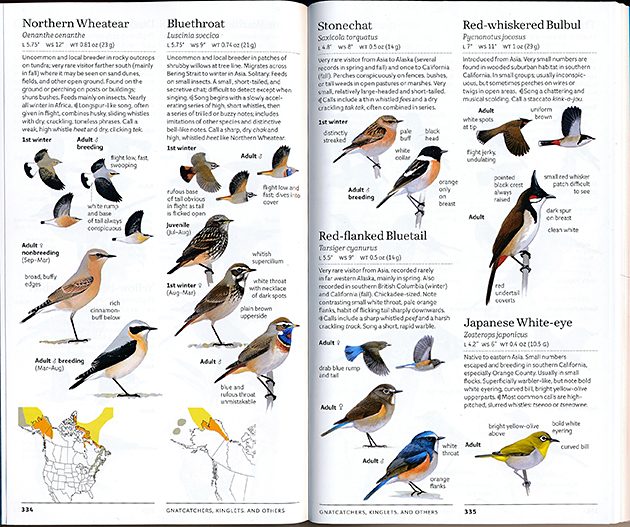
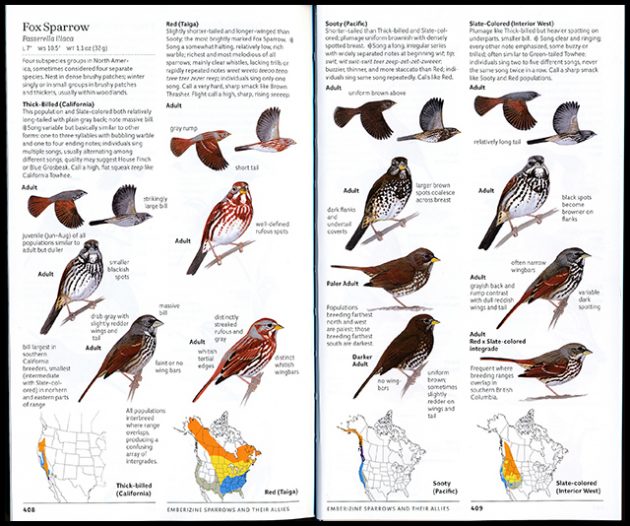

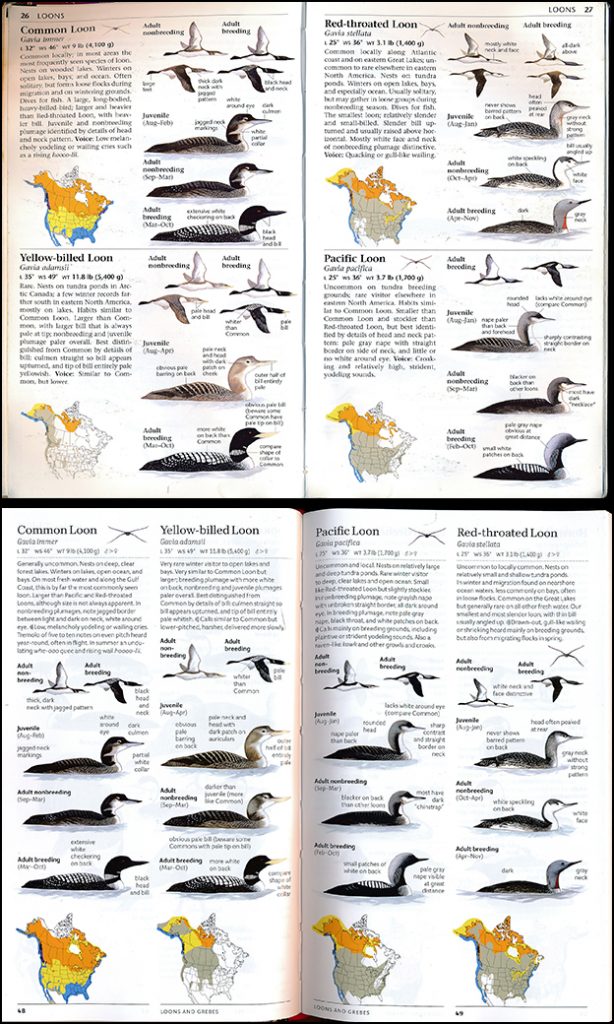
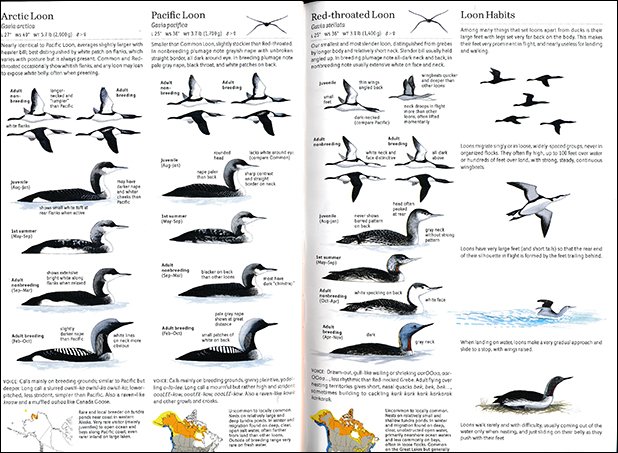
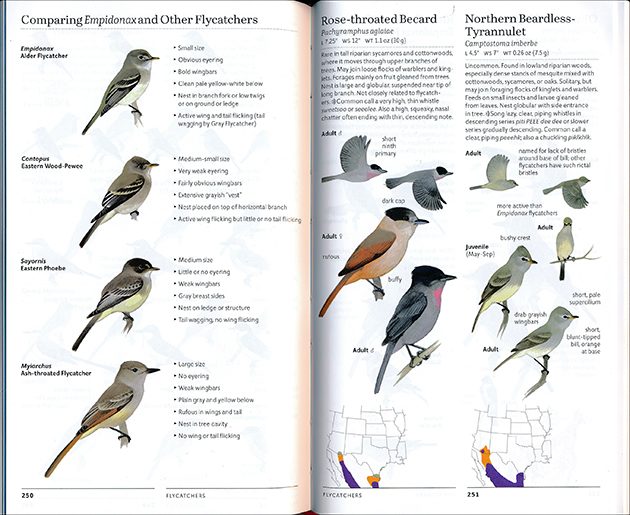
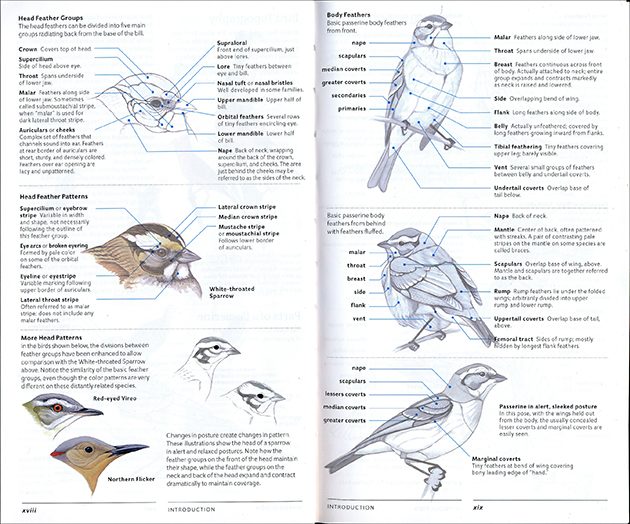











I see it still clings to Imperial units. 🙂
Thank you for a tremendous review of the guide that I lean on the most. While mine does fall open to the Emberizine sparrows all by it’s self! Very well written.
Thank you, Tom! Yes, the Emberizine sparrow pages are pretty worn in my 2003 book too, but not as much as shorebirds and the spread on Common and Forster’s Terns.
Duncan, not sure what you mean by Imperial units. Inches?